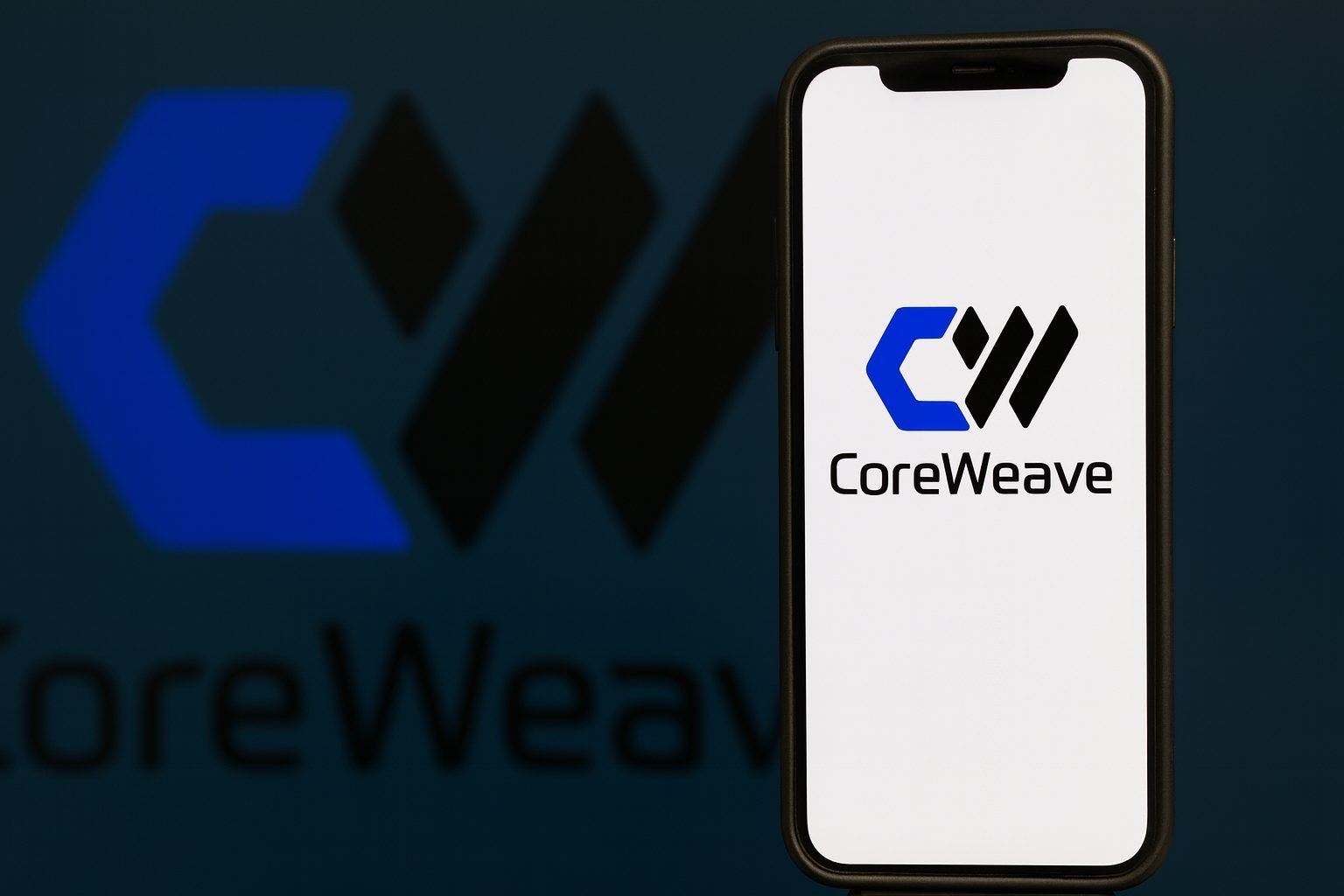CoreWeave, Inc. (NASDAQ: CRWV) heads into the shortened Black Friday session on November 28 as one of Wall Street’s most closely watched artificial intelligence (AI) infrastructure plays — and one of its most volatile.
After one of 2025’s hottest IPOs, the Nvidia‑backed GPU cloud provider has been hammered by an AI sector pullback, data‑center hiccups, aggressive capital spending and mounting legal scrutiny. At the same time, CoreWeave keeps signing multi‑billion‑dollar AI contracts and attracting “smart money” buyers like ARK Invest and Bridgewater Associates.
Here’s what traders and investors need to know about CoreWeave stock before the U.S. market reopens on Friday, November 28, 2025.
CoreWeave stock snapshot before Friday’s open
- Last close (Wednesday, November 26, 2025):
CoreWeave shares closed at $74.29, up 4.21% on the day, with roughly 28.7 million shares traded. The stock is down sharply from its highs but remains up strongly year‑to‑date. [1] - Market value and trading range:
At that closing price, CoreWeave’s market capitalization is about $37 billion, on trailing 12‑month revenue of roughly $4.3 billion and a net loss of about $825 million, implying a price‑to‑sales ratio near 8.6× and a price‑to‑book ratio around 9.5×. The stock’s 52‑week range runs from $33.51 to $187.00, meaning shares are still more than 60% below their peak but more than double the low. [2] - Liquidity, short interest and volatility:
Average daily volume sits around 30 million shares, and short interest is estimated at ~33 million shares, about 10% of the free float, with a short‑interest ratio just over one day — a setup that can amplify moves both up and down. Daily volatility over the past week has hovered around 10%, underscoring how sentiment‑driven the name has become. [3] - Friday’s session is a holiday short day:
U.S. equity markets are closed on Thanksgiving Day (Thursday, Nov. 27) and reopen on Friday, Nov. 28 for a shortened “Black Friday” session, traditionally with lighter volume and elevated single‑stock swings. [4] - Modelled expectations for November 28:
Technical research site StockInvest projects that CoreWeave could open near $74.58 on Friday and trade in a wide intraday range between roughly $70.22 and $78.36, implying a potential ±11.6% swing versus Wednesday’s close. Those figures are statistical forecasts based on recent volatility, not guarantees. [5]
All of this leaves CoreWeave entering Friday’s open as an oversold, heavily shorted, high‑beta AI proxy at the exact moment the broader market is debating whether the AI trade has become a bubble.
From blockbuster IPO to deep drawdown
CoreWeave went public on March 28, 2025, in one of the year’s most talked‑about tech listings, raising hundreds of millions of dollars at an IPO price of $40 per share. The stock quickly rocketed to about $187 as investors piled into anything tied directly to the AI infrastructure build‑out. [6]
The company’s pitch is straightforward:
- It runs a GPU‑focused cloud optimized for training and running large AI models.
- It is deeply tied into Nvidia’s ecosystem and was early to deploy next‑generation GPU systems at scale.
- It powers workloads for front‑line AI customers including OpenAI, Microsoft and Meta Platforms, as well as other AI labs and enterprises. [7]
As contracts flooded in, CoreWeave became a kind of pure‑play bet on AI data‑center demand, and its valuation followed. But since peaking around the mid‑$180s, the share price has fallen more than 60%, even after recent bounces — a drop steeper than many diversified “AI winners” like Microsoft or Alphabet. [8]
Part of that decline reflects a broader rotation out of high‑multiple AI names and part reflects company‑specific worries about execution, leverage and legal risk.
Q3 2025: revenue beats, guidance cut and data‑center delays
CoreWeave reported third‑quarter 2025 results on November 10, delivering numbers that looked strong on the surface — but spooked investors once management’s guidance and infrastructure updates hit the tape. [9]
Key takeaways:
- Revenue: about $1.36 billion, topping Street estimates near $1.29 billion and up triple digits year‑over‑year.
- Profitability: adjusted operating income came in near $217 million, but the company still posted a GAAP net loss of roughly $110 million for the quarter. [10]
- Backlog: CoreWeave said its revenue backlog swelled to more than $55 billion, nearly doubling from the prior quarter, reflecting large multi‑year contracts with giants such as Meta, Nvidia and OpenAI. [11]
The problem wasn’t demand — it was capacity:
- Management disclosed that a third‑party developer partner is behind schedule on building out new data‑center capacity, limiting how quickly CoreWeave can convert backlog into revenue.
- As a result, the company trimmed its 2025 revenue guidance to roughly $5.05–$5.15 billion, down from earlier forecasts around $5.15–$5.35 billion, even as it reaffirmed massive capex plans. [12]
The market reaction was harsh: despite the revenue beat, CoreWeave stock sold off in double‑digit percentage terms in the sessions around the report, contributing to a roughly 45% slide from recent highs before the latest rebound. [13]
Those guidance cuts and capacity hiccups are now at the center of shareholder‑rights investigations. Law firms Bronstein, Gewirtz & Grossman and Pomerantz have both announced probes into whether CoreWeave or its officers may have misled investors in connection with the Q3 update and subsequent stock decline — early‑stage inquiries that underscore how closely the company’s disclosures are being scrutinized. [14]
November deal flow: mega‑contracts, storage partnerships and new products
Despite the stock’s correction, CoreWeave has continued to announce big commercial wins and financing moves throughout October and November.
1. $14.2 billion Meta AI infrastructure deal
In late September, CoreWeave announced a cloud computing agreement with Meta Platforms worth up to $14.2 billion through December 2031, with an option to extend into 2032. The deal gives Meta access to CoreWeave’s AI‑optimized infrastructure, including the latest Nvidia GPU systems, and was widely seen as a major step in diversifying CoreWeave’s revenue beyond Microsoft and OpenAI. [15]
According to Barron’s, the Meta agreement followed earlier multi‑billion‑dollar contracts with Nvidia and OpenAI, including:
- A roughly $6.3 billion deal with Nvidia, under which Nvidia commits to buying unused CoreWeave capacity.
- A newly expanded $6.5 billion contract with OpenAI, lifting the total value of their partnership to about $22.4 billion. [16]
Wall Street welcomed the Meta news at the time, driving CoreWeave shares up more than 15% in a single session — a reminder that positive contract headlines can still move the stock sharply in either direction. [17]
2. $1.17 billion data‑storage partnership with Vast Data
On November 6, Reuters reported that Nvidia‑backed Vast Data signed a $1.17 billion commercial agreement with CoreWeave, making Vast the company’s primary data platform for its AI cloud infrastructure. [18]
Under the multi‑year deal:
- CoreWeave will rely on Vast’s software to store and process the enormous datasets used to train and run AI models.
- The companies will align product roadmaps to improve data handling efficiency for AI workloads.
The agreement further embeds CoreWeave in a web of specialized AI infrastructure suppliers, while giving Vast a major recurring‑revenue stream of its own. [19]
3. Zero Egress Migration: attacking hyperscaler lock‑in
On November 13, CoreWeave rolled out its Zero Egress Migration (0EM) program — a “no‑egress‑fee” initiative aimed squarely at luring AI workloads away from the big three hyperscalers. [20]
According to the company:
- Customers can move large datasets directly from providers such as AWS, Azure and Google Cloud into CoreWeave’s AI Object Storage without paying data egress fees for the initial migration.
- The program offers a fully managed, validated migration service, with no forced account closures or exit penalties.
- CoreWeave says typical customers can save up to $1 million in egress fees, while gaining up to 7 GB/s per GPU throughput and multi‑cloud flexibility once their data is on the platform. [21]
In simple terms, 0EM is designed to undercut one of the biggest financial friction points in cloud computing — data transfer fees — and make it easier for AI‑heavy customers to diversify away from legacy hyperscalers.
4. Expanded revolving credit facility
Also in mid‑November, CoreWeave expanded its revolving credit facility from $1.5 billion to $2.5 billion and extended the maturity from May 2028 to November 2029, in a deal with a consortium of banks. [22]
The company framed the move as:
- Evidence of lender confidence in its business model and growth trajectory.
- A way to secure additional financial flexibility to fund capex and working capital as it builds more AI data centers.
For investors, the bigger revolver underscores both CoreWeave’s access to credit markets and the reality that its growth strategy is exceptionally capital‑intensive.
Debt, customer concentration and AI‑bubble worries
CoreWeave’s growth story is impressive — but it comes with heavyweight risks that are front and center in recent research.
High leverage and negative earnings
Analysts at TipRanks and The Motley Fool have highlighted three recurring concerns: high leverage, customer concentration and rich valuation. [23]
From recent data and filings:
- CoreWeave carries close to $14 billion of debt on its balance sheet as of Q3, and net interest expense for the first nine months of 2025 totaled more than $840 million. [24]
- The company has guided for $12–14 billion in capital expenditures for 2025, with its CFO signalling that 2026 capex will be “well in excess of double” that amount, implying potentially $24–28 billion or more in spending next year. [25]
- Despite surging revenue, CoreWeave remains unprofitable on a GAAP basis, with net losses in the hundreds of millions per year. [26]
On top of that, Finviz data shows a debt‑to‑equity ratio of about 4.85, a profit margin around –19%, and an enterprise value of more than $53 billion — numbers that support the current debate about whether the stock’s risk/return profile still makes sense after the pullback. [27]
Extreme customer concentration
CoreWeave’s own S‑1 filing shows that in 2024, roughly 77% of revenue came from its top two customers, with the largest single customer accounting for about 62% of revenue — widely understood to be Microsoft/OpenAI. [28]
Those contracts are structured with substantial “take‑or‑pay” minimums, which provide near‑term revenue visibility but raise questions about how flexible customers will want future agreements to be if the AI build‑out slows or pricing power shifts back toward buyers.
AI bubble chatter and accounting concerns
CoreWeave has also become a poster child in the wider AI‑bubble debate:
- Ray Dalio, founder of Bridgewater Associates, has warned that AI stocks are trading at bubble‑like valuations, even as his own hedge fund has bought CoreWeave shares (more on that below). [29]
- Investor Michael Burry has accused big tech companies of inflating AI profits by extending the depreciable life of GPUs and servers far beyond their true economic life, potentially overstating AI‑related earnings by tens of billions of dollars in coming years. While CoreWeave isn’t the primary target of Burry’s criticism, any eventual re‑rating of AI infrastructure returns could impact how investors value its long‑term contracts. [30]
- Commentators have also highlighted the sector’s increasingly complex, debt‑fuelled financing structures, where Nvidia, AI cloud providers and credit investors all have intertwined exposure, adding another layer of risk if AI spending decelerates. TechStock²+1
Put together, these factors have made CoreWeave one of the most controversial AI names on the market: loved by growth bulls, targeted by short sellers and scrutinized by credit and equity analysts alike.
Legal and deal‑making uncertainty: the failed Core Scientific merger
Another storyline hanging over CoreWeave is its aborted attempt to acquire Core Scientific (NASDAQ: CORZ), a major data‑center and crypto‑mining infrastructure operator.
- In October 2025, Core Scientific shareholders rejected a roughly $9 billion all‑stock merger with CoreWeave, effectively killing the deal. [31]
- The proposed transaction would have given Core Scientific investors less than 10% of the combined company and tied their fate to CoreWeave’s volatile share price via a fixed exchange ratio. [32]
- Activist investors and proxy advisers argued the offer undervalued Core Scientific and exposed its shareholders to too much risk given CoreWeave’s high leverage and stock swings. [33]
At the same time, shareholder‑rights firms including Johnson Fistel and Halper Sadeh have launched investigations into whether Core Scientific’s board fulfilled its fiduciary duties in negotiating the sale, while separate firms probe CoreWeave itself. [34]
Although the terminated merger doesn’t directly alter CoreWeave’s balance sheet, it:
- Removes one potential avenue for rapidly adding power and data‑center capacity.
- Reinforces that major counterparties are wary of taking on CoreWeave equity risk on unattractive terms.
- Adds another layer of headline and legal risk around the stock.
Both companies have said they intend to keep collaborating commercially, but for now, CoreWeave must pursue its infrastructure expansion without the benefit of that large, vertically integrated deal. [35]
Who’s buying (and selling) CoreWeave stock?
Despite the drawdown and legal noise, big institutional money is still actively trading CRWV — on both sides.
Bridgewater Associates steps in
A new report from Barchart, citing regulatory filings, says Bridgewater Associates bought about 270,556 CoreWeave shares last quarter, a position valued at roughly $37 million at the time of the filing. [36]
The purchase is notable because it comes as founder Ray Dalio is publicly warning that AI stocks are displaying classic bubble characteristics — suggesting that, at least for now, the world’s largest hedge fund sees tactical or long‑term opportunity in CoreWeave despite those concerns. [37]
ARK Invest continues to “buy the dip”
Cathie Wood’s ARK Invest has repeatedly been flagged as a consistent dip‑buyer in CRWV since the stock’s post‑earnings sell‑off:
- Financial news outlets and holdings disclosures show ARK’s flagship ARK Innovation ETF (ARKK) and ARK Next Generation Internet ETF (ARKW) adding CoreWeave shares across multiple November trading sessions, turning the stock into a meaningful AI infrastructure bet in both funds. [38]
- A widely circulated analysis noted that ARK has accumulated tens of millions of dollars worth of CoreWeave across its ETFs, effectively signalling high conviction in the company’s long‑term positioning despite short‑term volatility. TechStock²+1
Other institutional movers and Wall Street views
- A quant firm XTX Topco has also initiated or increased a CRWV stake, according to MarketBeat’s tracking of institutional filings.
- On the other side, media reports suggest some hedge funds, including Coatue Management, have trimmed CoreWeave positions while rotating into other growth names, highlighting the split opinion among sophisticated investors. TechStock²
Analyst sentiment is similarly mixed:
- Finviz aggregates a consensus recommendation around 2.1 (“Buy”), with an average Wall Street price target near $131, implying substantial upside from current levels — at least on paper. [39]
- TipRanks reports a “Moderate Buy” rating based on a near‑even split between Buy and Hold recommendations, with an average price target around $148, roughly 100% above recent prices, albeit with one Sell rating in the mix. [40]
In short, institutional capital is far from unanimous: some of the world’s best‑known growth and macro investors are leaning in, while others are clearly taking chips off the table.
Key levels and themes to watch on November 28
Heading into Friday’s session, traders watching CRWV may focus on a mix of technical levels and narrative catalysts:
Technical picture
- Wednesday’s close at $74.29 sits just above short‑term support near $71–72 and below nearby resistance in the mid‑$70s to upper‑$70s, according to technical projections. [41]
- The stock is trading in the lower portion of a wide, downward‑sloping trend channel, and both StockInvest’s models and Finviz’s indicators flag CoreWeave as “very high risk” with an oversold RSI near 30. [42]
- StockInvest’s model sees a possible intraday swing of ±11–12% on Friday, which would not be unusual given recent history. [43]
Fundamental and news catalysts
Short‑term moves could be driven by:
- AI sector sentiment: Any fresh headlines around Nvidia, big‑tech capex plans, or AI “bubble” commentary can spill over quickly into CoreWeave. [44]
- Follow‑through on November deals: Investors will watch for customer commentary or analyst updates on the Meta, Nvidia, OpenAI and Vast Data agreements, particularly any details on implementation timelines and margins. [45]
- Financing developments: After expanding its revolver, CoreWeave’s next bond issue, credit facility usage, or guidance on 2026 capex could quickly change perceptions of balance‑sheet risk. [46]
- Legal headlines: New statements from law firms or regulators regarding ongoing investigations could add incremental pressure, even if they don’t immediately translate into lawsuits. [47]
For now, the tug‑of‑war between “hyper‑growth AI leader” and “highly leveraged, execution‑sensitive story” is what makes CRWV such a volatile trading vehicle.
Bottom line: high‑growth AI bellwether with binary‑feeling risks
Going into the November 28, 2025 open, CoreWeave stands out as:
- A central player in the AI infrastructure arms race, with tens of billions of dollars in contracted backlog and marquee customers like Meta, Nvidia, OpenAI and Microsoft. [48]
- A company with impressive top‑line momentum — Q3 revenue and backlog both beat expectations — but no GAAP profits, rising interest expense and an appetite for capex measured in tens of billions of dollars. [49]
- A stock that has become a lightning rod for AI‑bubble, leverage and governance debates, as reflected in short‑seller interest, shareholder‑rights investigations and polarized analyst coverage. TechStock²+2Bronstein, Gewirtz & Grossman, LLC+2
- A name where top‑tier institutions are actively trading both sides — with ARK and Bridgewater among recent buyers and other funds reportedly paring back exposure. [50]
For traders and investors watching CoreWeave before Friday’s bell, the setup is clear: huge potential upside if the AI build‑out continues on script and CoreWeave executes flawlessly — and equally substantial downside if demand, financing conditions or execution stumble.
Important note
This article is for informational and news purposes only and does not constitute financial, investment, tax or legal advice. CoreWeave stock is highly volatile and speculative; anyone considering an investment should perform their own research, review the company’s official filings and consult a qualified financial adviser before buying or selling securities.
References
1. finviz.com, 2. finviz.com, 3. finviz.com, 4. finance.yahoo.com, 5. stockinvest.us, 6. finviz.com, 7. investors.coreweave.com, 8. www.nasdaq.com, 9. investors.coreweave.com, 10. www.gurufocus.com, 11. www.gurufocus.com, 12. www.gurufocus.com, 13. www.gurufocus.com, 14. bgandg.com, 15. www.reuters.com, 16. www.barrons.com, 17. www.barrons.com, 18. www.reuters.com, 19. www.reuters.com, 20. investors.coreweave.com, 21. www.coreweave.com, 22. investors.coreweave.com, 23. www.tipranks.com, 24. www.nasdaq.com, 25. siliconangle.com, 26. www.nasdaq.com, 27. finviz.com, 28. www.nasdaq.com, 29. www.barchart.com, 30. 247wallst.com, 31. www.reuters.com, 32. www.ft.com, 33. www.reuters.com, 34. www.globenewswire.com, 35. www.reuters.com, 36. www.barchart.com, 37. www.barchart.com, 38. finviz.com, 39. finviz.com, 40. www.tipranks.com, 41. stockinvest.us, 42. stockinvest.us, 43. stockinvest.us, 44. 247wallst.com, 45. www.reuters.com, 46. investors.coreweave.com, 47. bgandg.com, 48. www.reuters.com, 49. www.gurufocus.com, 50. www.barchart.com







